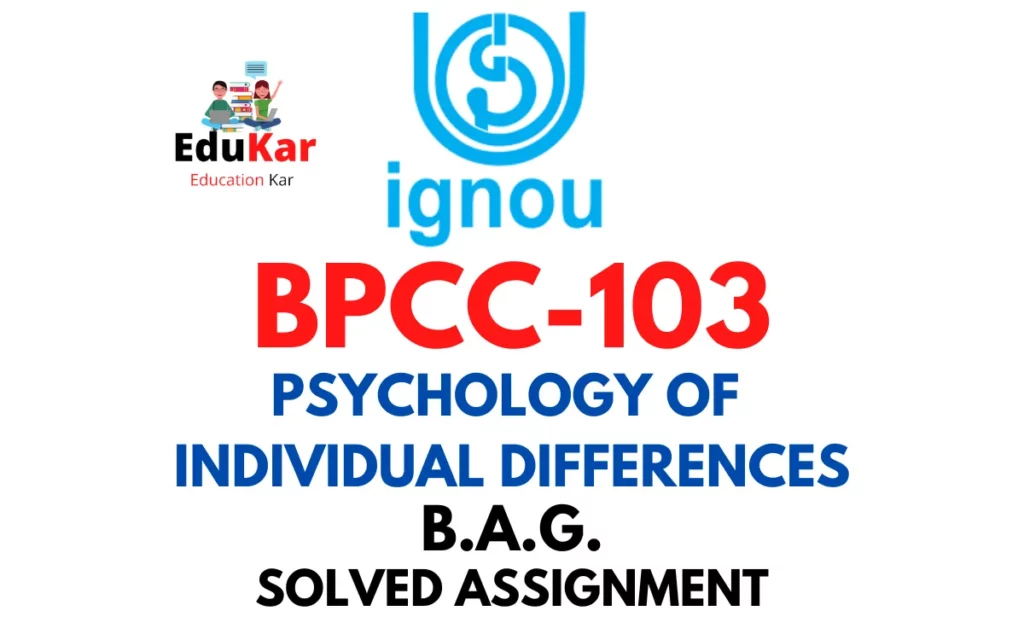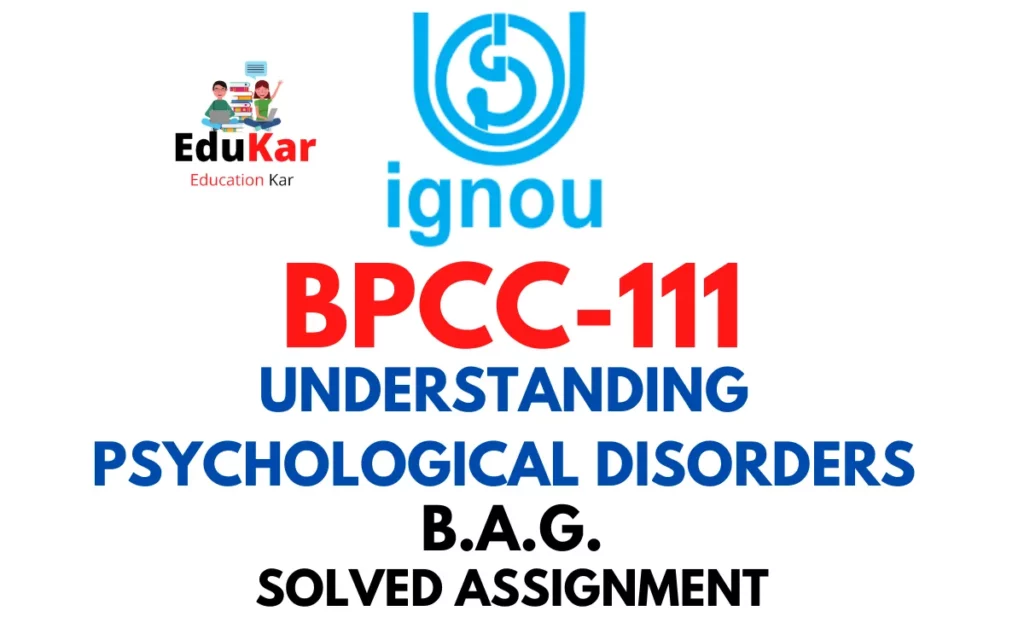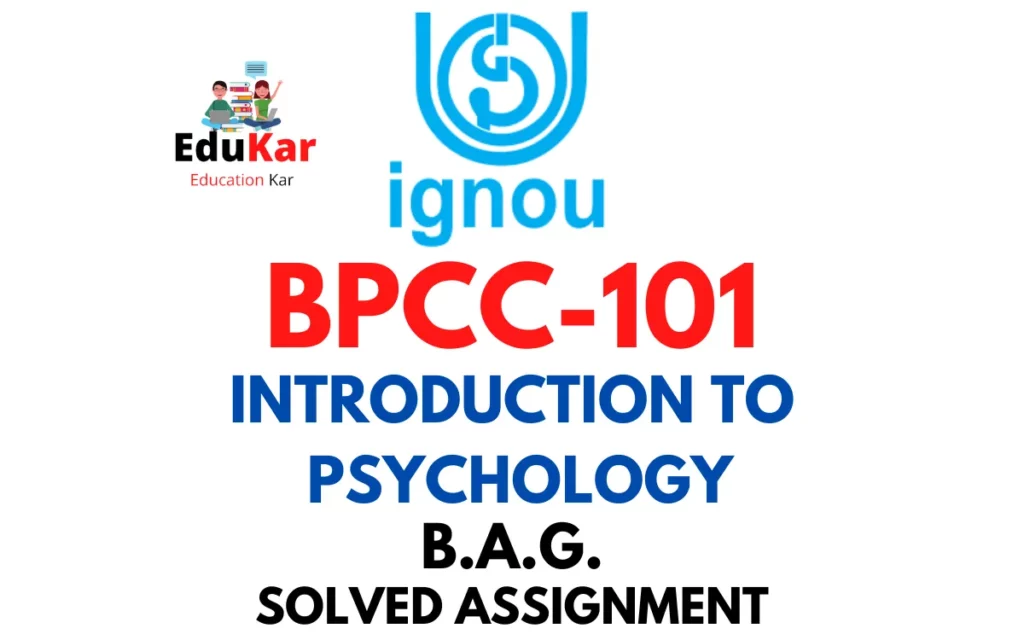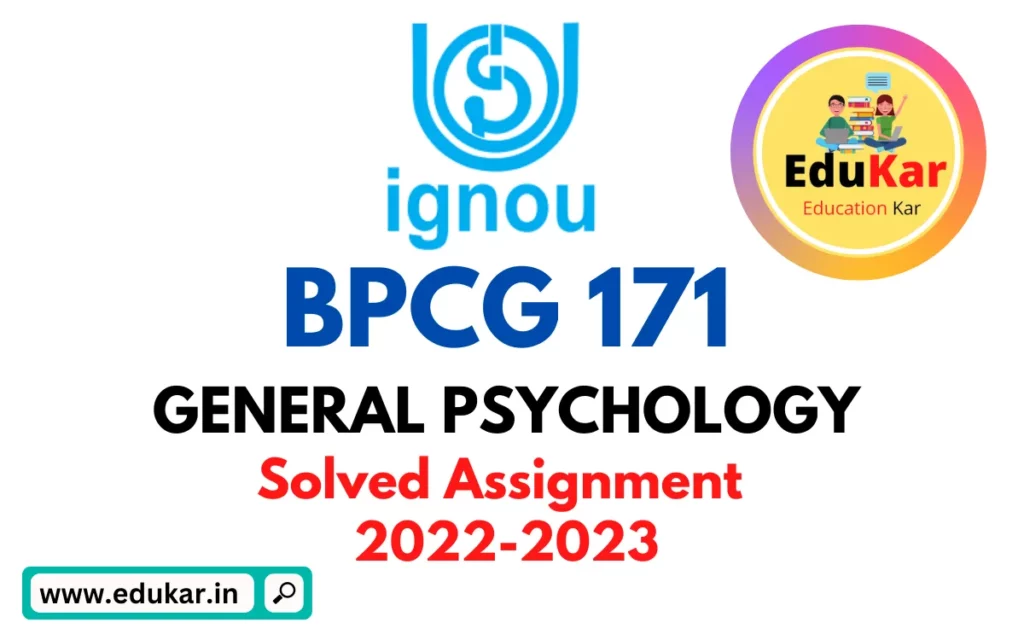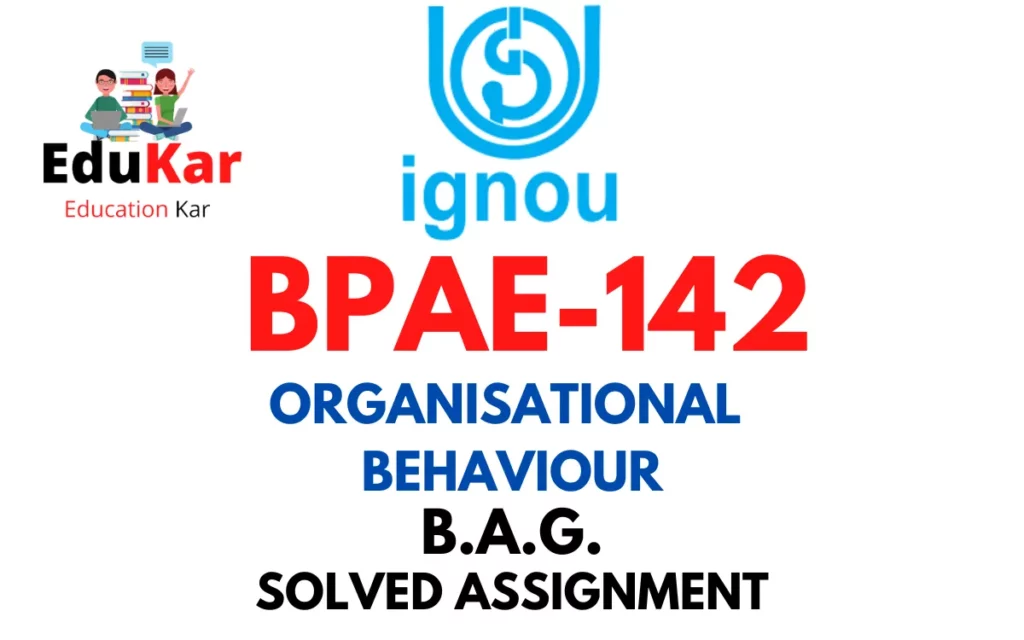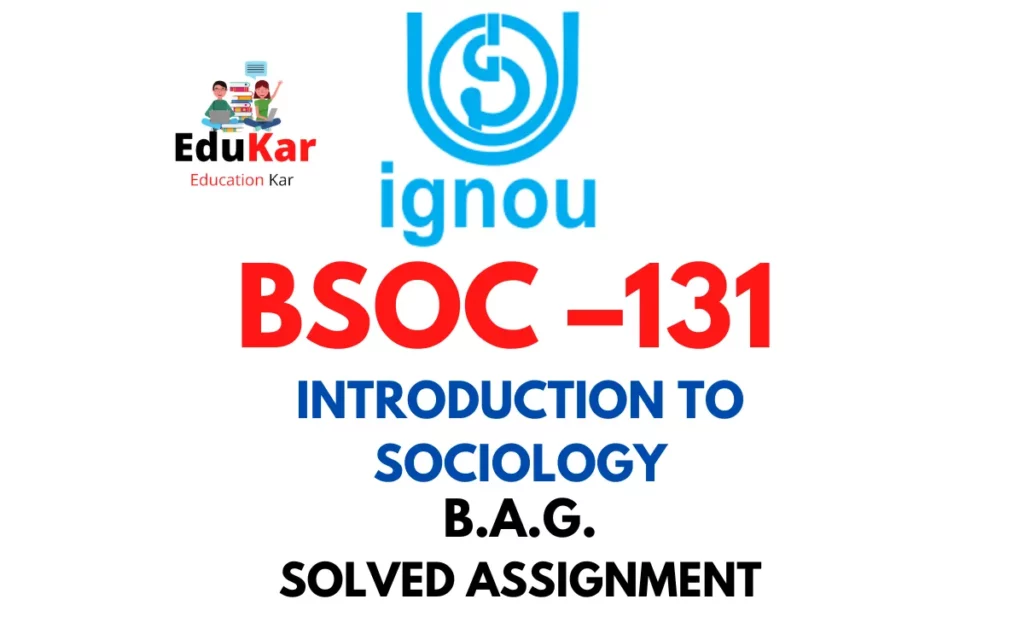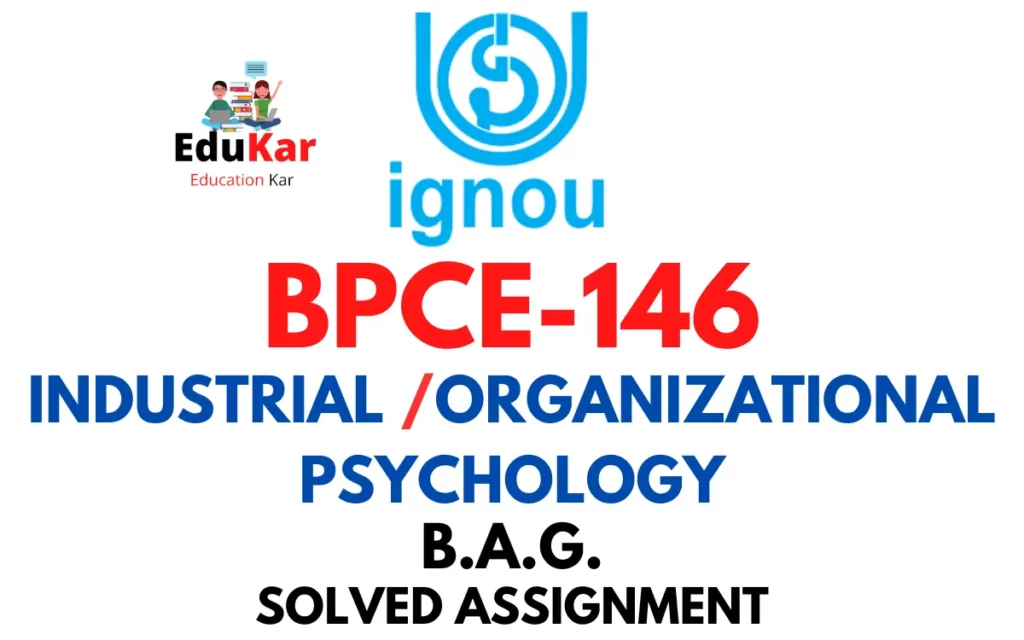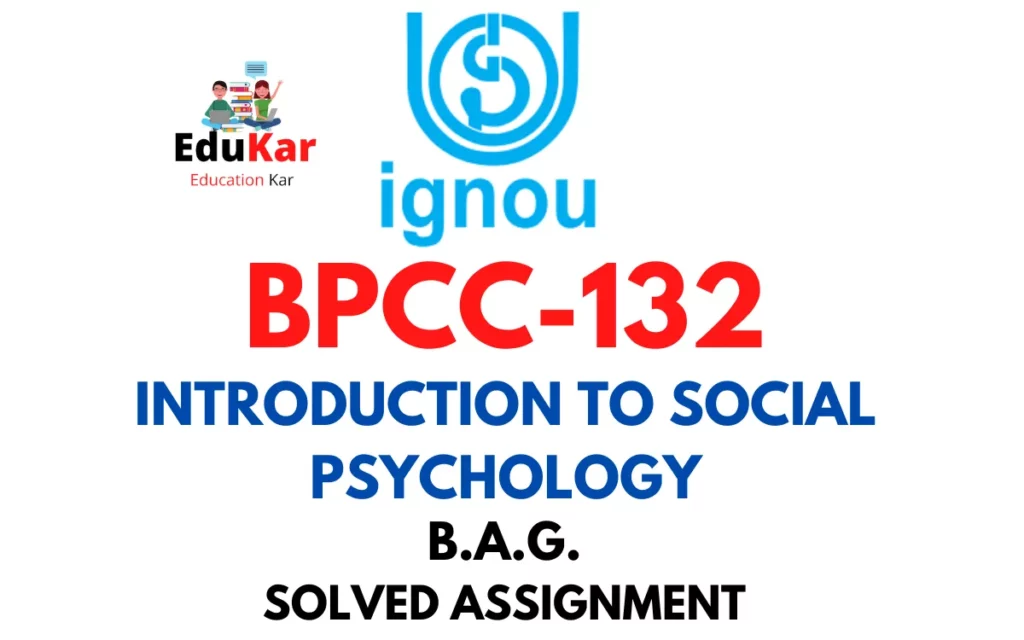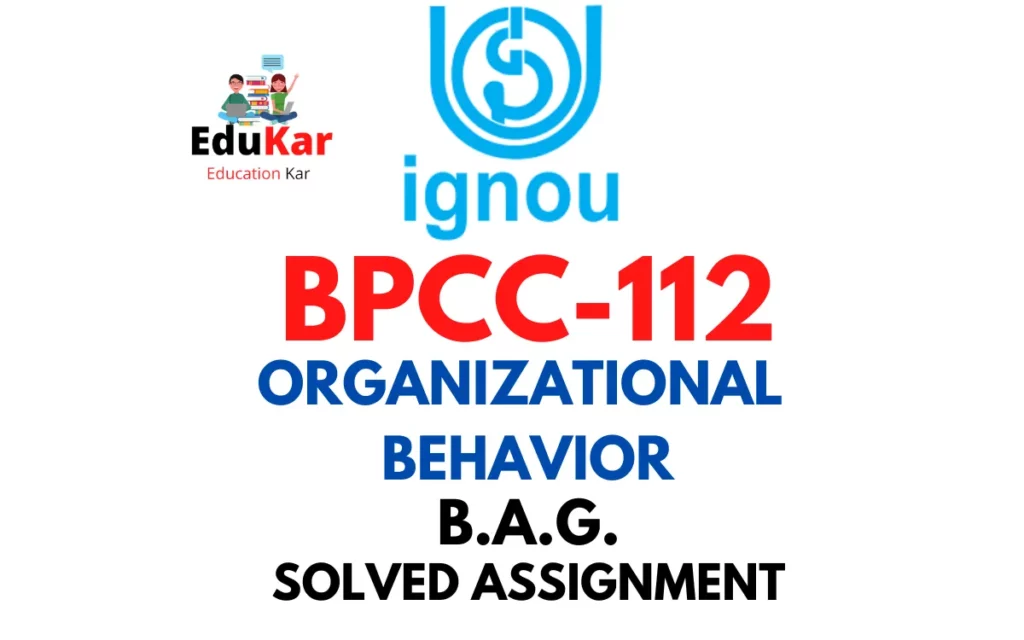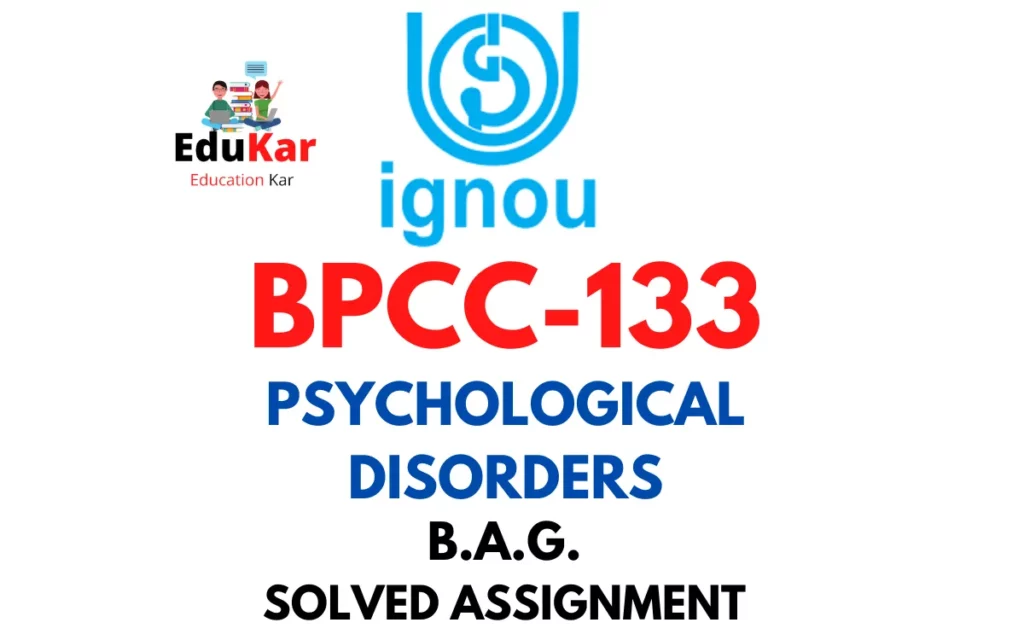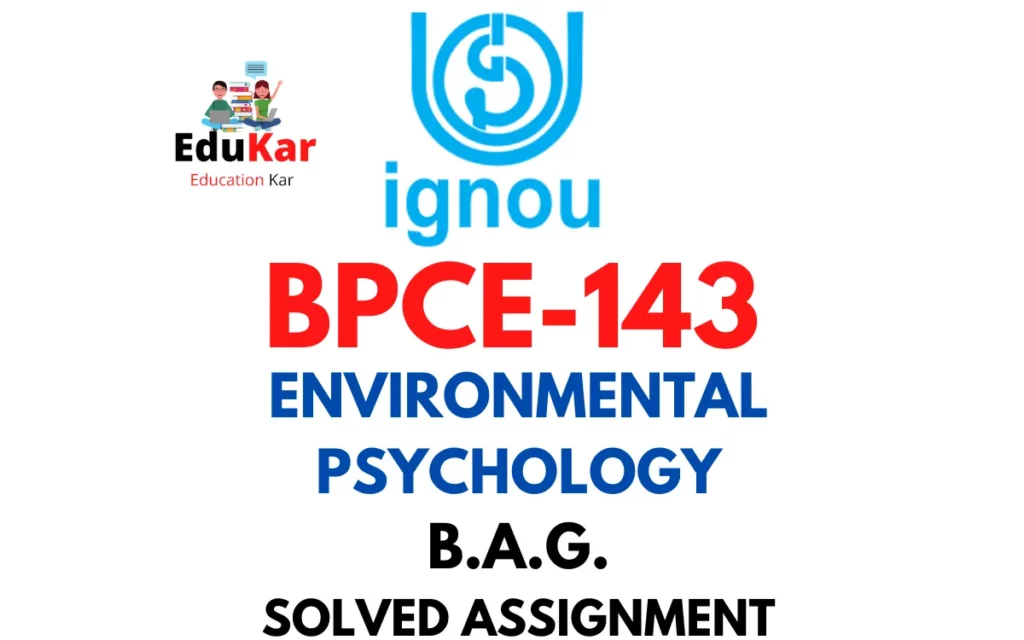Contents
- 1 Assignment One
- 2 Answer the following descriptive category questions in about 500 words each. Each question carries 20 marks.
- 3 1. Discuss the behavioural and cognitive theories of personality.
- 4 2. Explain the psychometric and cognitive approaches to intelligence.
- 5 3. Explain the differences between Indian and Western psychology.
- 6 Assignment Two
- 7 Answer the following short category questions in about 100 words each. Each question carries 5 marks.
- 8 4. Explain the measurement of intelligence.
- 9 5. Differentiate between aptitude and interest.
- 10 6. Discuss the meaning of the term Indian Psychology.
- 11 7. Differentiate between ‘Atman’ and ‘Jiva’.
- 12 8. Explain the optimal arousal theory.
- 13 9. Discuss the stages of creativity.
- 14 10. Describe different tests for assessing creativity.
- 15 11. Discuss ways to increase extrinsic motivation.
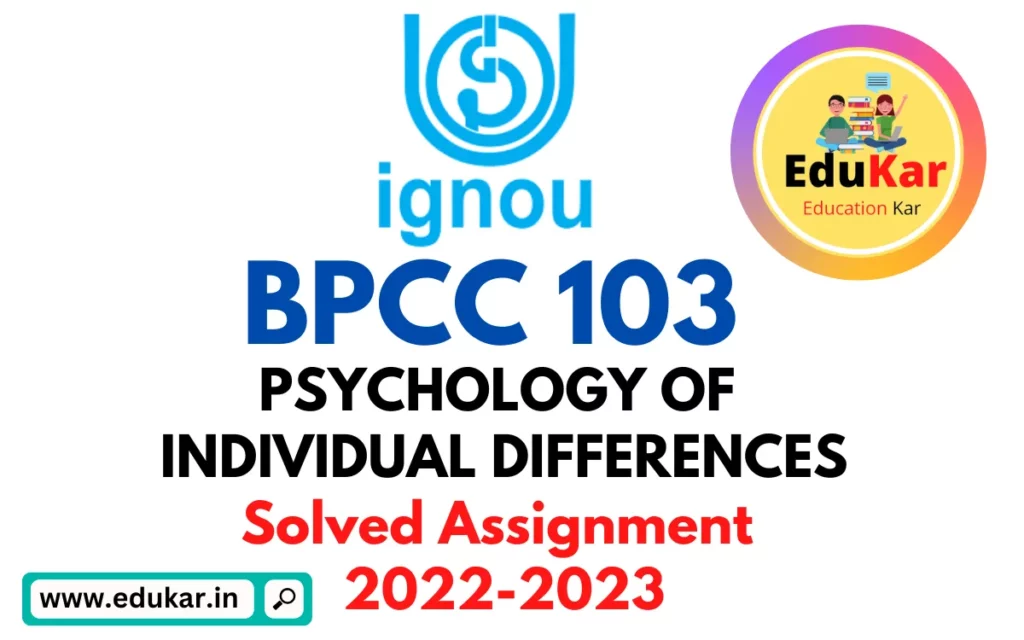
| Title | BPCC 103: IGNOU BAG Solved Assignment 2022-2023 |
| University | IGNOU |
| Degree | Bachelor Degree Programme |
| Course Code | BPCC 103 |
| Course Name | PSYCHOLOGY OF INDIVIDUAL DIFFERENCES |
| Programme Name | Bachelor of Arts (General) |
| Programme Code | BAG |
| Total Marks | 100 |
| Year | 2022-2023 |
| Language | English |
| Assignment Code | Asst /TMA /2022-23 |
| Last Date for Submission of Assignment: | For June Examination: 31st April For December Examination: 30th September |
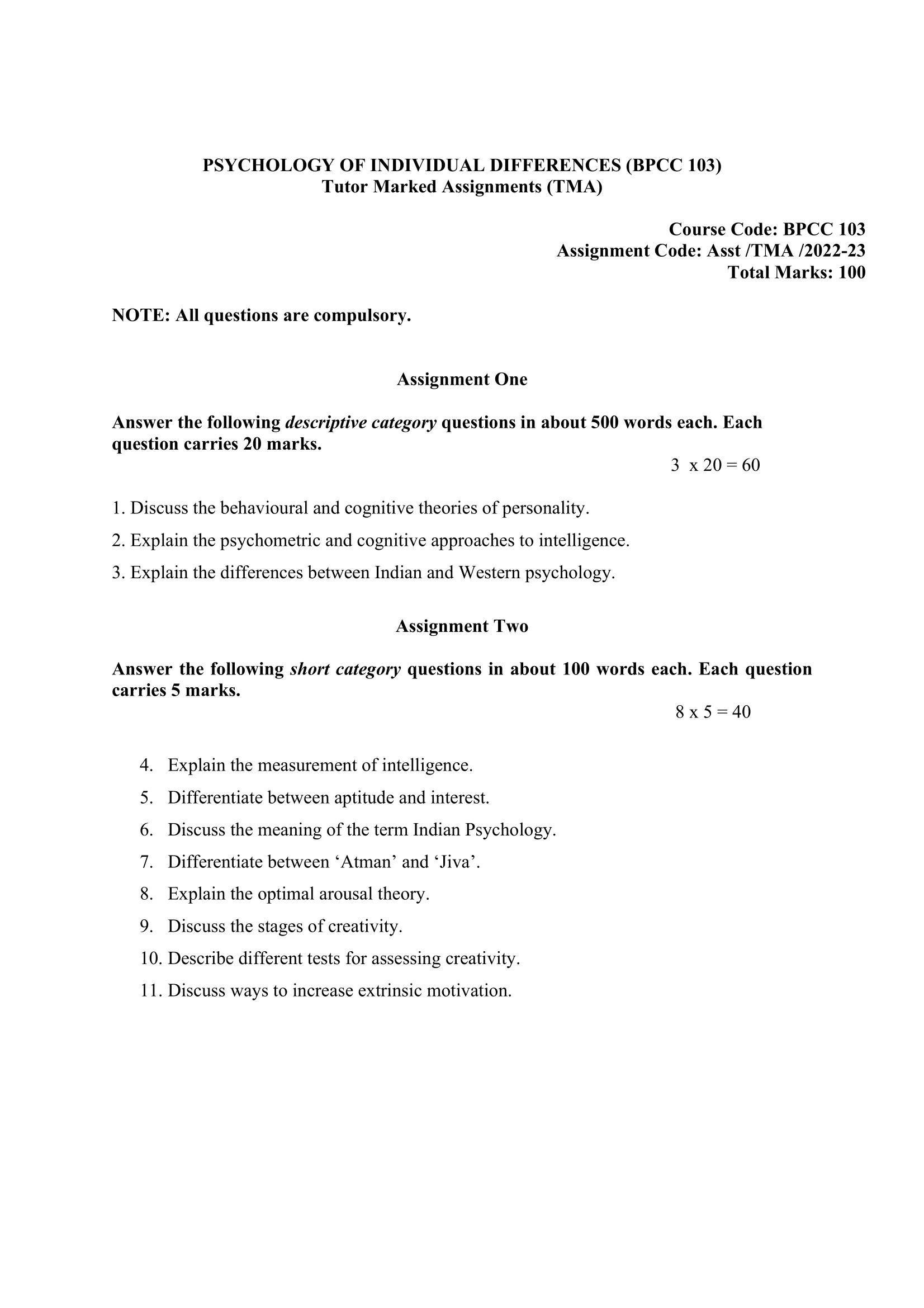
Assignment One
Answer the following descriptive category questions in about 500 words each. Each question carries 20 marks.
1. Discuss the behavioural and cognitive theories of personality.
Ans: Personality is a complex and multi-faceted concept that has been studied by psychologists for many years. Two major approaches to understanding personality are the behavioral and cognitive theories.
The behavioral theory of personality views personality as a learned set of behaviors that are shaped by reinforcement and punishment. This approach argues that personality is formed through the interactions between an individual and their environment, and that behavior is shaped by the consequences that follow. For example, if a behavior is consistently reinforced, it is more likely to become a part of an individual’s personality. This approach is often associated with the work of B.F. Skinner and his theory of operant conditioning.
The cognitive theory of personality, on the other hand, views personality as the result of an individual’s thoughts, attitudes, and beliefs. This approach argues that an individual’s personality is shaped by their perception of their environment and the interpretation of their experiences. For example, an individual who perceives their environment as supportive and safe is likely to have a more positive personality than an individual who perceives their environment as threatening and unpredictable. This approach is often associated with the work of cognitive psychologists such as Albert Bandura and Aaron Beck.
One key difference between the behavioral and cognitive theories of personality is their focus on the causes of behavior. The behavioral theory emphasizes the role of environmental factors, such as reinforcement and punishment, while the cognitive theory emphasizes the role of internal mental processes, such as thoughts and attitudes.
Another difference between the two theories is their approach to change. The behavioral theory argues that personality can be changed through modifying environmental factors, such as reinforcement or punishment. The cognitive theory, on the other hand, argues that personality can be changed through changing an individual’s thoughts and attitudes, which can alter their perception of their environment and their behavior.
Both the behavioral and cognitive theories of personality have their strengths and limitations. The behavioral theory provides a useful framework for understanding the role of environmental factors in shaping personality, but it can be limited in its ability to account for the complexity of human behavior. The cognitive theory provides a useful framework for understanding the role of internal mental processes in shaping personality, but it can be limited in its ability to account for the influence of environmental factors.
2. Explain the psychometric and cognitive approaches to intelligence.
Ans: Intelligence is a complex concept that has been studied for centuries by psychologists, with varying perspectives and definitions. Two major approaches to understanding intelligence are the psychometric approach and the cognitive approach.
The psychometric approach views intelligence as a measurable trait that can be assessed through standardized tests and quantified by intelligence quotient (IQ) scores. This approach focuses on the measurement of intelligence and identifies patterns of mental abilities, such as reasoning, memory, and perception, that are consistently correlated with intelligent behavior. The development of intelligence tests, such as the Stanford-Binet and Wechsler Adult Intelligence Scale, has helped establish a standardized approach to assessing intelligence.
The cognitive approach, on the other hand, focuses on the internal processes and mechanisms that underlie intelligent behavior. This approach views intelligence as a set of mental processes, including attention, perception, memory, and problem solving, that are used to understand and interact with the world. Researchers using the cognitive approach study these processes to gain insight into how they work and how they can be improved.
One of the key differences between the psychometric and cognitive approaches is that the psychometric approach tends to emphasize the measurement of intelligence, while the cognitive approach focuses on understanding the mental processes that contribute to intelligent behavior. For example, a psychologist using the psychometric approach might administer an intelligence test to assess a person’s IQ score, while a psychologist using the cognitive approach might study the person’s problem-solving skills or memory abilities to gain insight into their intelligence.
Another difference between the two approaches is that the psychometric approach tends to be more objective and quantitative, while the cognitive approach is often more subjective and qualitative. For example, intelligence tests are often scored using a standardized procedure, while the results of a cognitive study might be interpreted in a more subjective manner.
Both the psychometric and cognitive approaches have their strengths and limitations. The psychometric approach is useful for assessing intelligence in a standardized and objective manner, but it can be limited in its ability to capture the complex and nuanced aspects of intelligent behavior. The cognitive approach provides a more in-depth understanding of the mental processes that underlie intelligent behavior, but it can be limited in its ability to quantify and compare levels of intelligence.
3. Explain the differences between Indian and Western psychology.
Ans: Indian and Western psychology are two distinct psychological traditions that have evolved over time and have different philosophical and cultural roots. Despite some similarities, there are also several important differences between Indian and Western psychology.
One of the key differences between Indian and Western psychology is the philosophical foundations. Indian psychology is based on a holistic, holistic approach that views the mind and body as interconnected, while Western psychology is based on a reductionist approach that views the mind and body as separate entities. Indian psychology is also influenced by the philosophy of yoga and the idea of consciousness as a fundamental aspect of reality, while Western psychology is influenced by the scientific method and the idea of objective, empirical observation.
Another important difference between Indian and Western psychology is their approach to mental disorders. Indian psychology views mental disorders as a disturbance of the mind-body-spirit balance, and emphasizes the importance of holistic treatment methods, such as meditation and yoga, to restore balance. Western psychology, on the other hand, views mental disorders as biological or psychological problems and emphasizes the use of drugs and therapy to treat them.
A third difference between Indian and Western psychology is the approach to consciousness and self-awareness. Indian psychology views consciousness as a fundamental aspect of reality and emphasizes the importance of self-awareness and introspection as a means of understanding the self and the world. Western psychology views consciousness as a result of brain function and emphasizes the importance of objective, empirical observation to understand the self and the world.
Finally, there is a difference in the focus of research between Indian and Western psychology. Indian psychology tends to focus on the study of human experience and spirituality, while Western psychology tends to focus on the study of the brain and behavior.
Assignment Two
Answer the following short category questions in about 100 words each. Each question carries 5 marks.
4. Explain the measurement of intelligence.
Ans: Intelligence can be defined as an individual’s ability to learn, understand, and apply information and knowledge. Intelligence is a complex and multi-faceted concept, and as a result, there are a variety of ways to measure it.
One of the most commonly used methods for measuring intelligence is intelligence quotient (IQ) tests. IQ tests are standardized tests that measure a range of cognitive abilities, such as verbal and mathematical reasoning, memory, and spatial awareness. These tests provide a score that is meant to reflect an individual’s overall intellectual ability.
Another approach to measuring intelligence is the use of aptitude tests. Aptitude tests measure an individual’s potential for success in specific areas, such as music, art, or science. These tests assess an individual’s innate abilities and can provide valuable information about their strengths and weaknesses.
Additionally, some researchers have advocated for the use of more holistic and culturally sensitive measures of intelligence, such as the concept of emotional intelligence. Emotional intelligence refers to an individual’s ability to understand and manage their own emotions, as well as the emotions of others.
5. Differentiate between aptitude and interest.
Ans: Aptitude and interest are two distinct concepts that are related to an individual’s abilities and preferences.
Aptitude refers to an individual’s innate ability to learn and perform a particular task or activity. It is a measure of an individual’s potential for success in a specific area and is typically assessed through aptitude tests. For example, an individual may have a high aptitude for mathematics, meaning that they have the potential to excel in this subject with proper training and practice.
Interest, on the other hand, refers to an individual’s preferred activities or hobbies. It is a measure of an individual’s likes and dislikes and is often assessed through interest inventories. For example, an individual may have an interest in music, meaning that they enjoy listening to music and may choose to pursue musical activities in their free time.
6. Discuss the meaning of the term Indian Psychology.
Ans: The term “Indian Psychology” refers to the psychological tradition that has evolved in India over the centuries. It is a unique and distinct tradition that has its roots in ancient Indian philosophy, spirituality, and religion.
Indian Psychology is based on a holistic and philosophical approach that views the mind and body as interconnected and inseparable. It emphasizes the importance of self-awareness and introspection as a means of understanding the self and the world. Indian Psychology also views consciousness as a fundamental aspect of reality and views mental disorders as a disturbance of the mind-body-spirit balance.
The main goals of Indian Psychology are to understand the nature of the mind, the self, and human behavior, and to develop techniques for promoting mental and emotional well-being. Indian Psychology has contributed a number of important concepts to the field of psychology, such as the idea of karma, which refers to the belief that our actions in this life will determine our experiences in future lives, and the idea of yoga, which refers to the practice of meditation and physical postures aimed at promoting mental and physical well-being.
7. Differentiate between ‘Atman’ and ‘Jiva’.
Ans: “Atman” and “Jiva” are two key concepts in Hindu philosophy and spirituality that are relevant to Indian Psychology.
Atman refers to the ultimate reality or the true self of an individual. It is considered to be a divine spark within each person and is considered to be unchanging, eternal, and indestructible. The concept of Atman is closely linked to the idea of Brahman, which is the ultimate reality that underlies all of creation. In Hindu philosophy, the ultimate goal of life is to realize one’s Atman and to merge with the ultimate reality of Brahman.
Jiva, on the other hand, refers to the individual self or the living being. It is considered to be a temporary and changing aspect of reality, and is believed to be separate from the ultimate reality of Atman and Brahman. Jiva is associated with the individual’s physical and mental experiences, and is considered to be the source of all desires and attachments.
8. Explain the optimal arousal theory.
Ans: The optimal arousal theory is a psychological theory that proposes that there is an optimal level of arousal, or level of activation, that leads to optimal performance. The theory suggests that both too much and too little arousal can have a negative effect on performance.
According to the optimal arousal theory, high levels of arousal can lead to anxiety and nervousness, which can impair performance by increasing distractions and reducing focus. On the other hand, low levels of arousal can lead to boredom and lack of motivation, which can also impair performance.
The optimal arousal theory proposes that there is an ideal level of arousal, often referred to as the “Goldilocks zone,” where an individual is neither too excited nor too relaxed. This optimal level of arousal is believed to be associated with peak performance and maximum motivation.
The theory has been applied to a wide range of performance domains, including sports, music, and academic achievement. It has been used to help individuals and teams identify and regulate their arousal levels in order to improve performance and achieve optimal results.
9. Discuss the stages of creativity.
Ans: Creativity is a complex and multi-faceted process that can be broken down into several stages. The following are the stages of creativity:
- Preparation: This is the first stage of creativity and involves gathering information and ideas, setting goals, and generating initial concepts. This stage is characterized by a focus on research and exploration.
- Incubation: During this stage, the individual sets aside the problem or task at hand and allows their unconscious mind to process the information and ideas gathered in the preparation stage.
- Illumination: This is the “aha!” moment in the creative process, where a new and original idea suddenly appears. It is a moment of sudden insight and inspiration.
- Verification: In this stage, the individual evaluates and tests their idea to see if it is feasible and practical. This may involve further research and exploration, as well as consultation with others.
- Elaboration: This is the stage where the individual develops and refines their idea. It may involve exploring different possibilities and variations, as well as testing and refining the idea to make it more practical and feasible.
- Implementation: The final stage is the implementation of the idea, where the individual puts their idea into action. This may involve creating a product or service, or presenting their idea to others for feedback.
It’s worth noting that these stages are not always linear and may occur in different orders or be skipped entirely. Additionally, creativity is a dynamic and ongoing process that may involve repeating these stages multiple times.
10. Describe different tests for assessing creativity.
Ans: There are several tests used to assess creativity, each with a different focus and methodology. Some of the most commonly used tests for assessing creativity include:
- Torrance Tests of Creative Thinking (TTCT): This test measures an individual’s ability to generate new and original ideas, think divergently, and overcome blocks to their thinking. It is often used to assess creativity in children.
- Abbreviated Torrance Test for Adults (ATA): Similar to the TTCT, the ATA measures an individual’s ability to generate new and original ideas and think divergently. It is specifically designed for use with adults.
- Remote Associates Test (RAT): This test measures an individual’s ability to find relationships between seemingly unrelated concepts and generate new and original ideas based on those relationships.
- Divergent Thinking Test (DT): This test measures an individual’s ability to generate a large number of creative ideas in response to a prompt. The results of the DT test can be used to assess an individual’s overall level of creativity.
- The Creative Achievement Questionnaire (CAQ): This test measures an individual’s level of creative achievement in various domains, including the arts, sciences, and humanities. It provides a comprehensive evaluation of an individual’s creative potential and can be used to identify areas of strength and weakness.
- Picture Completion Test (PCT): This test measures an individual’s ability to think creatively and generate new and original ideas in response to a visual prompt. It is often used to assess creativity in children and is considered a good predictor of creative potential.
11. Discuss ways to increase extrinsic motivation.
Ans: Extrinsic motivation refers to the external factors that drive an individual’s behavior, such as rewards, punishments, or recognition. Here are several ways to increase extrinsic motivation:
- Offer incentives: This can include tangible rewards, such as bonuses or gifts, or intangible rewards, such as praise or recognition. Incentives can be used to motivate individuals to work harder or reach specific goals.
- Provide feedback: Regular feedback, both positive and constructive, can help individuals see their progress and feel motivated to continue working hard. Feedback can also help individuals see areas for improvement and work towards making changes.
- Set clear goals: Setting clear, achievable goals can help individuals focus their efforts and feel motivated to reach their targets. Providing regular updates on progress towards those goals can also help maintain motivation.
- Create a positive work environment: A supportive and encouraging work environment can help individuals feel motivated and engaged in their work. This can include opportunities for collaboration and recognition, as well as a healthy work-life balance.
- Offer opportunities for advancement: Providing opportunities for advancement, such as promotions or training, can help individuals feel motivated to continue developing their skills and growing their careers.
- Encourage competition: Competition can be a powerful motivator, especially if it is well-structured and based on fair criteria. Encouraging friendly competition among peers or teams can help individuals work harder and feel more motivated.
How to Download BPCC 103 Solved Assignment?
You can download it from the www.edukar.in, they have a big database for all the IGNOU solved assignments.
Is the BPCC 103 Solved Assignment Free?
Yes this is absolutely free to download the solved assignment from www.edukar.in
What is the last submission date for BPCC 103 Solved Assignment?
For June Examination: 31st April, For December Examination: 30th October

